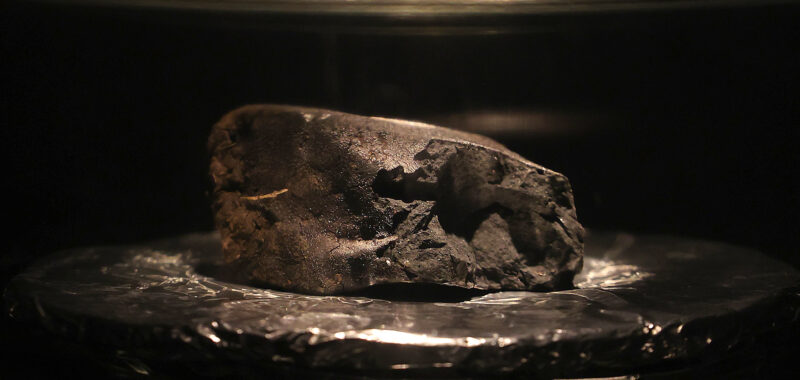
Adapted from How to Kill an Asteroid: The Real Science of Planetary Defense by Robin George Andrews. Copyright © 2024 by Robin George Andrews. Used with permission of the publisher, W. W. Norton & Company, Inc. All rights reserved.
It took a few days to be convinced, Rob Wilcock told me, sipping his coffee in a London bookstore’s café. “I don’t think about meteorites. I don’t know how unusual they are.” All he, his wife Cathryn, and his daughter Hannah knew was that they had about eleven ounces of black sooty something “in a Waitrose freezer bag” sitting in their house. “In the utility room, of course,” he added, next to a food processor. “Next door had twenty grams” (less than an ounce). Only after they had scooped up the mystery matter, and after having seen planetary scientists froth excitedly about a new meteor all over the news, did Rob come to a confident conclusion: that charred confetti in their house had to have come from outer space.
The Wilcocks hail from the English town of Winchcombe, which, until March 2021, was like several other settlements in the Cotswolds: bucolic, home to verdant countryside panoramas, masterfully manicured gardens, and a requisite castle. It was used to hosting visitors from around the UK and even farther afield. But on February 28, it received a visitor that had traveled a record-breaking distance. At about 10 p.m. local time, it exploded fairly quietly in the night sky, sending pieces in all directions. At the time, the only people that noticed were members of the UK Fireball Alliance, a group of meteor aficionados led by the Natural History Museum in London. The alert went out: something just blew up over the county of Gloucestershire. What happened to it?
Like many residents of Winchcombe that serene Sunday night, Rob, Cathryn, and Hannah were chilling out at home. Hannah, who was upstairs in a road-facing bedroom, thought she heard a clattering noise, a bit like a picture frame falling off the wall in another room. Unable to identify the source, she didn’t think much of it until the next morning, when she looked outside at the driveway and saw a pile of Stygian soot. The trio went outside and stared at it. Did someone throw this at them? Did a cryptic beast leave it as some sort of message?
Rob texted his sons—POSSIBLY FROM SPACE?—accompanied by images of the peculiar pile. That’s when one of his sons, Daniel, alerted them to fireball reports across the region. Rob leaped online, and he found an alert sent out by scientists to those in the county: if you live in the area and you have found something weird and rock-like that wasn’t there before, for the love of God, please do not ignore it, or wash it away with a hose—keep it somewhere safe.
Imagine you’re in this situation, and you aren’t a scientist or someone who’s made space their hobby. What would you do if you were confronted with a pile of extraterrestrial dandruff on your driveway? They didn’t know if it was hazardous or volatile, Cathryn told me. Should they go near it? It looked like an anthill made of coffee grounds, and although it would have probably made an out-of-this-world espresso, they did what any sensible family would have done at that stage: put on rubber gloves, scoop it into polyethylene sandwich bags and plastic yogurt pots, brush in the smaller bits with toothbrushes and stainless steel knives, seal it all up, and put it in the house.

